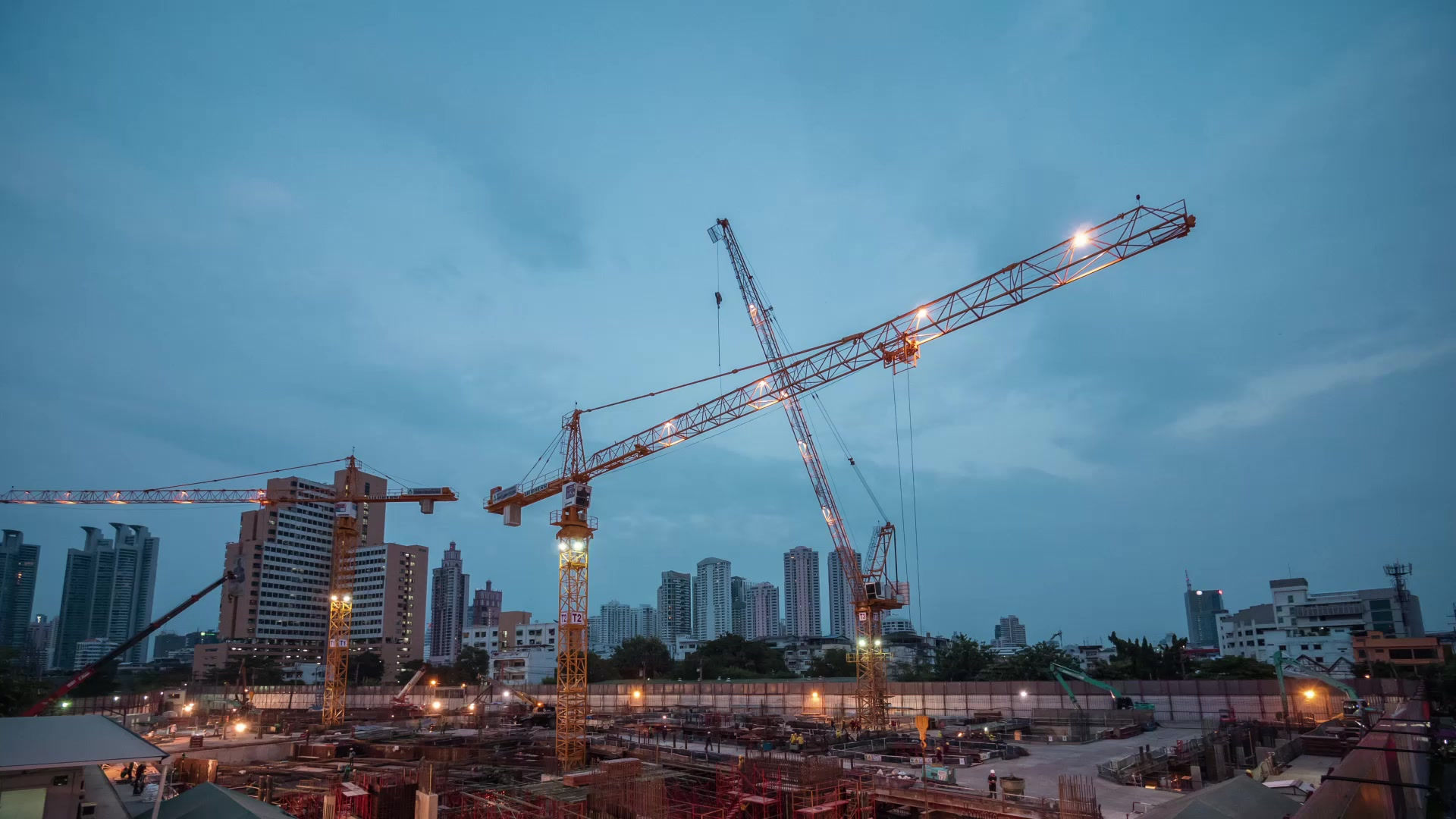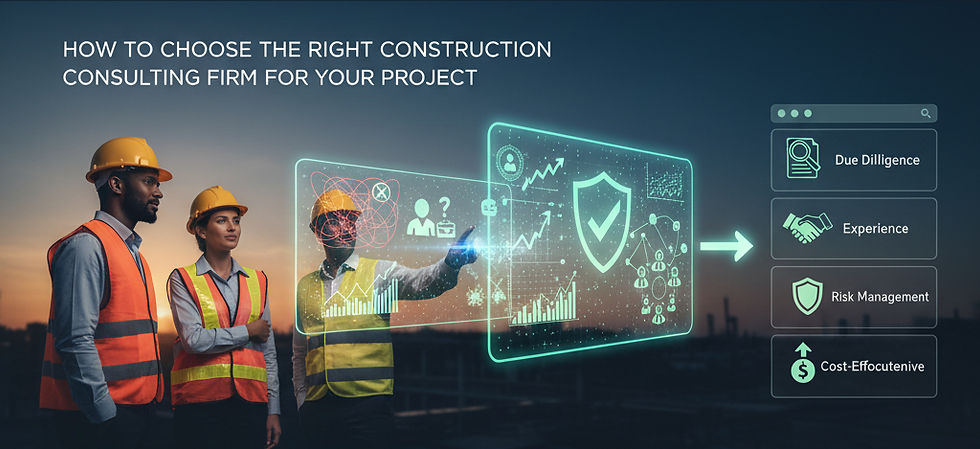Risk Management in Construction Consulting
- Daphne Garcia
- Oct 6
- 4 min read
Every construction project, no matter its size, carries risk. From unexpected cost overruns and delays to safety hazards and regulatory issues, a single miscalculation can affect timelines, budgets, and even reputations. For this reason, risk management in construction consulting service has become a cornerstone of successful project delivery.
Consultants provide property owners, developers, and contractors with structured strategies to identify, assess, and mitigate risks before they spiral out of control. By doing so, they safeguard investments and give stakeholders the confidence to move projects forward.
The Role of Risk Management in Modern Construction
Construction is unpredictable because it involves so many moving parts—labor, materials, weather conditions, financing, and compliance with laws. The complexity grows even further in large-scale developments. Without dedicated planning, the risks include:
Financial setbacks from underestimated costs or market changes
Timeline disruptions due to labor shortages or supply chain delays
Safety violations that can lead to accidents, lawsuits, or project shutdowns
Disputes and litigation between owners, contractors, and subcontractors
Reputation damage for developers if projects finish late or over budget
By investing in construction risk management services, stakeholders reduce the likelihood of these outcomes and gain a structured approach for achieving long-term project success.
For context on how risk fits into the broader scope of construction planning, see A Comprehensive Guide to Construction Services, which outlines where consulting delivers the most value.
Core Elements of Construction Consulting for Risk Management
1. Financial Risk Control
Financial issues are one of the most common causes of project failure. Risk consultants:
Conduct cost-benefit analysis before construction begins.
Provide accurate cost forecasting to avoid budget shortfalls.
Monitor expenses throughout the project lifecycle.
Advise on securing funding or financial protection through insurance.
Example: A mid-rise apartment development in a major city faced rising steel costs mid-project. Because consultants had already built escalation clauses into contracts, the developer avoided unplanned expenses.
2. Schedule Risk Mitigation
Time delays are costly, especially for projects tied to investor milestones or lease agreements. Consultants:
Develop realistic timelines with built-in buffers.
Coordinate trades and suppliers to minimize downtime.
Use scheduling software to track progress and dependencies.
Create contingency plans for weather disruptions or labor shortages.
Example: On a healthcare facility build, risk consultants accounted for seasonal weather patterns. When heavy rains caused delays, contingency measures allowed crews to reallocate resources and stay on track.
3. Safety and Compliance Oversight
Worksite safety remains a major risk category. Consultants:
Conduct hazard assessments before and during construction.
Ensure adherence to OSHA and local regulations.
Provide safety training for contractors and staff.
Audit compliance at regular intervals.
Example: A contractor avoided costly shutdowns after consultants flagged missing safety signage early in the project, preventing violations during a surprise inspection.
4. Contract and Legal Risk Management
Poorly written contracts often lead to disputes that halt progress. Consultants:
Review and draft clear, enforceable agreements.
Establish responsibilities, penalties, and performance standards.
Facilitate resolution when conflicts arise.
Example: On a large commercial project, consulting services helped mediate a payment dispute between subcontractors and the general contractor, keeping the project moving without litigation.
5. Environmental and Site Risk Management
Projects are often affected by conditions beyond human control. Consultants:
Assess soil, drainage, and topography before site work begins.
Evaluate environmental regulations, such as emissions or waste disposal.
Plan for potential zoning or permitting delays.
Example: In a mixed-use development, consultants identified contaminated soil early and helped secure environmental remediation permits, avoiding major delays mid-project.
Tools and Strategies Used in Risk Consulting
Professionals offering construction risk management services employ a variety of structured tools:
Risk Registers: Centralized documents for tracking threats and solutions.
Probability-Impact Matrices: Ranking risks by likelihood and potential damage.
Scenario Planning: Preparing responses to “what-if” situations.
Insurance and Bonding Strategies: Transferring risks where appropriate.
Regular Reporting Systems: Keeping stakeholders informed and engaged.
By using these strategies, consultants ensure that risks are not just identified but actively managed.
Benefits of Hiring Risk Management Consultants
Engaging construction consulting for risk management provides measurable advantages:
Stronger budget control and fewer cost surprises
Projects that finish closer to planned timelines
Safer, more compliant work environments
Reduced disputes and legal battles
Higher confidence among investors, tenants, and end users
For a broader look at where consulting fits in beyond risk management, explore Key Construction Consulting Services Every Project Needs.
What About the Costs?
Some developers hesitate to add risk consultants due to budget concerns. But the reality is that consulting often saves money in the long run by avoiding overruns, shutdowns, or penalties.
To understand what goes into budgeting for these services, see Construction Consulting Service Costs: What to Expect, which breaks down typical pricing models and considerations.
Real-World Example: Risk Management in Action
A high-rise office project in a dense urban environment faced multiple risks: zoning delays, escalating material prices, and union labor negotiations. By engaging risk management consultants, the developers:
Created alternate schedules to account for permit delays.
Locked in material pricing early through negotiated supplier contracts.
Built contingency labor agreements to minimize strikes.
The result? The project finished only two weeks behind schedule (instead of the predicted four months) and within 3% of the original budget—a major success in such a high-risk environment.
Conclusion
Construction will always carry uncertainty, but effective risk management ensures that challenges don’t become disasters. Triple G Enterprises integrates risk management into its construction consulting services, giving developers and owners foresight, financial control, and confidence in project delivery.
From cost planning to compliance oversight, construction risk management services offer more than protection—they provide peace of mind. And when combined with broader consulting expertise, they help transform unpredictable projects into well-managed successes.

![MASTER LOGO 3G ENTERPRISE TEXAS LOGO LINE NO ENTERPRISE ONLY FINAL DESIGN PDF [Recovered]_](https://static.wixstatic.com/media/2785d0_6d5e092063c24e2e9876a02dacb2e3e9~mv2.png/v1/fill/w_121,h_109,al_c,q_85,usm_0.66_1.00_0.01,enc_avif,quality_auto/MASTER%20LOGO%203G%20ENTERPRISE%20TEXAS%20LOGO%20LINE%20NO%20ENTERPRISE%20ONLY%20FINAL%20DESIGN%20PDF%20%5BRecovered%5D_.png)




Comments